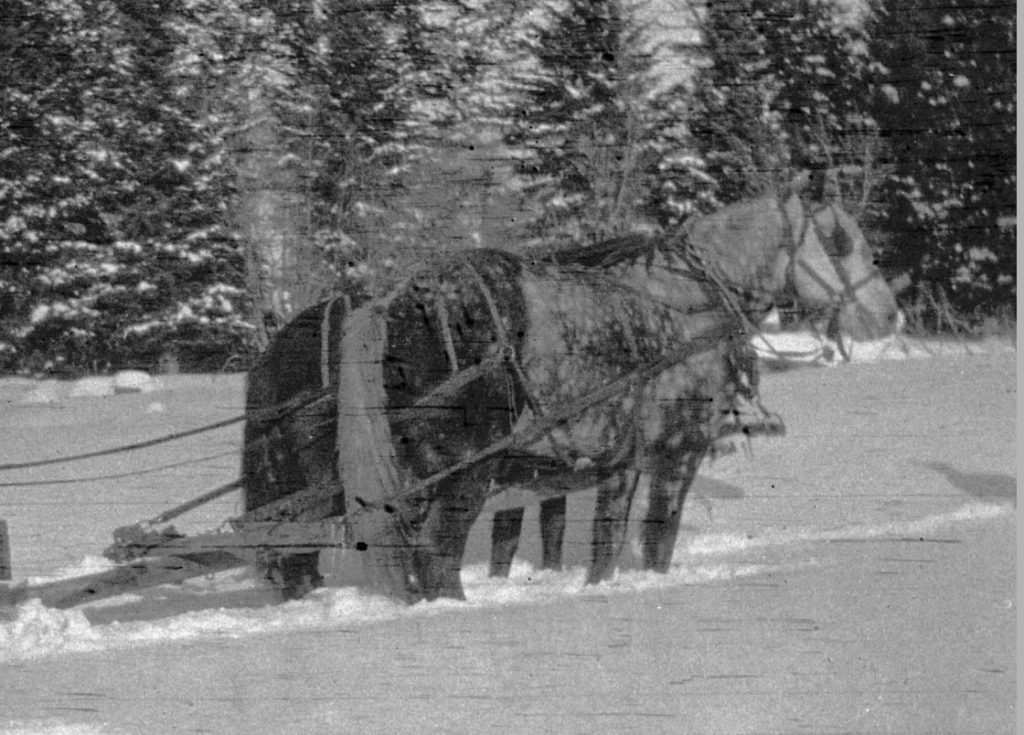My Guest Author, my dad, continues his project as he talks about the houses in which the family lived in the canyon. It wasn’t just people who needed housing, the animals did too, and Uncle Dick said some of the animals were people, too.
Now, that puts the family indoors, makes a bunk house for the work crew, and facilities for school. However, folks needed the help from the horses, milk from the cows, meat from a fatted calf, eggs from chickens. All of this protected by a dog. This meant housing for the horses, the cows, the hound dog, and the poultry. I’m not sure which shelter came first, likely a chicken coup and then shelter for the work horses or Suzie the black Jersey cow with horns. Sometime in Suzie’s life she was given housing privileges in that small log building that was moved and recycled to make the schoolhouse for Sister Ellen, Brother Jack, Cousin Billy, and Buster Woods. A cow shed and barn was built between the house and the property line. The front corner of the barn was about where the power pole now stands.
When I hit remembering age, we had Jitney and two teams of horses. Jitney was a buckskin mare mother got in a trade for two of Daddy and Ernest’s cows. Nina and Dolly were Daddy’s team. They were named after Nina Bea and Dolly Grey who were schoolteachers. Ernest’s team was named Punch and Schraeder. They would have been named Punch and Judy, but Judy died and was replaced by Schraeder – a half-eunuch horse named after Aunt Luella’s husband. The back corner of the barn housed two red milk cows that followed Suzie. They spent their energy fighting with each other. Their fights may have caused Delight to have a crippled calf.
The work horses had rooming rights on the front side of the barn. There were two or three two-horse sized stalls, a grain bin and room for hay, harness and horse-riding tack. One time Father went to a farm auction sale and bought what he thought was oyster shell for the chickens. When he got home, he opened the sack and found that it had rolled oats instead of oyster shell. He emptied it in the grain bin not knowing that they were poisoned oats[1]. The next evening Ernest fed his work team a scoop of grain. We were eating supper when there was a bang and crash sounding from the barn. One horse had fallen to the barn floor, the other horse was weak and trembling. The next several hours were spent doctoring poisoned horses.
A big barn was built in the early mid-thirties. That barn is still standing. A sizeable hay mow ran down the center of the barn. The north side was for horses and the south side was for two to four milk cows. They had their heads fastened in stanchions. A sizable calf pen and a maternity ward were on the cow side. There was also a walk-in bin for ground grain.
One day Baby Mary Jane tagged along with me when I put the feed out for the cows. A ruckus came from the bin. A weasel and a large rat were in a battle on top of the mound of grain. While I was filling mangers with hay, Little Sister Mary picked up a kitten and threw him in the bin with the rat and the weasel. I said, “Oh no!” and dropped the hay fork and ran down to rescue kitty Alexander.
When I got there the kitten was standing on the heap of grain trembling over a dead rat and a dead weasel. Baby sister thought she had a super kitten.
Most years we bought a couple of weaner pigs. We kept them in a pen near the door to the cow barn. They were fed a slop of separated milk and cooking scraps followed up with some ground grain. One autumn when the pigs were getting fat and lazy, the grain was poured out before they got the slop bucket full of milk. I was about four years old and was walking by the pig pen when one of the pigs choked to death. He took a jump at the fence, squealed, and fell over. I squealed and ran to the house for pig help. The hired man cut the pigs throat and we had fresh pork two months early. The schoolteacher, Mrs. Tippit, wouldn’t eat the pork. She went back to town a few weeks later, and that was the good news for the school year.
[1] Oats treated with strychnine were used to poison gophers, woodchucks, rats and mice.


